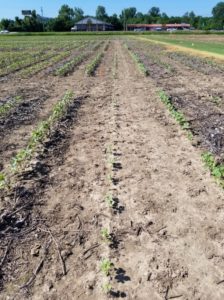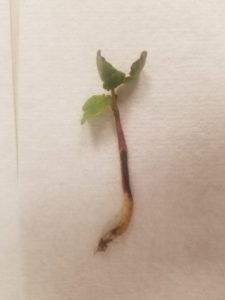So far, the cotton growing season in Tennessee has been a little on the cool side with highs in the mid 60’s for most days and typically dropping into the lower 40’s at night. In addition to cooler temperatures, there has also been frequent rain fall. These two factors could potentially play into cotton seedling disease development. There are four major pathogens that can cause seedling diseases in cotton. In the field, it can often be difficult to determine exactly which pathogen is causing the extent of the damage. So, we usually refer to the symptoms as a seedling disease complex. Although several pathogens may be causing damage simultaneously, there are some characteristic symptoms of individual diseases that can be identified. More detailed information on cotton seedling diseases can be found on guide.utcrops.com.
Rhizoctonia solani is the causal agent of sore shin in cotton. When present, sunken reddish-brown lesions near the soil line can form on the seedling stem. Lesions can progress, girdling the stem, causing the seedling to collapse. Overall stunting in seedling growth can also be common before lesions become visible.

Black root rot is caused by the fungus, Thielaviopsis basicola (syn. Berkeleyomyces basicola ). Symptoms of black root rot include initial delay in seedling growth, as well as, darkening of the tap root/ lateral roots. In severe cases, an overall loss of lateral roots can be expected. It is also common that the cortical tissue of the root will slide off easily when gripped firmly.

Both Pythium spp. and Fusarium spp. are associated with pre- and post- emergence damping off (seedlings dying before or after emergence) and Pythium spp. are usually the cause of seed rots. Whereas, Fusarium’s most common symptom is overall stunted growth. Seedlings infected with Pythium will exhibit “water-soaked” tan discoloration of the root system.

Levels of disease incidence and severity increase in fields that contain Root-Knot nematode (Meloidogyne incognita) and Reniform nematode (Rotylenchulus reiformis). Therefore, soil sampling for nematodes prior to planting season should highly be considered. Often, it is more than one pathogen causing poor emergence and/or seedling death.
For managing seedling diseases, crop rotation can to help control the severity of some infections. When applicable, planting time should also be delayed until the soil temperature is at least 65°F at your desired planting. Proper sterilization of planting equipment and the planting of good quality seed are also essential to developing healthy stands.
Seed treatments are the first line of defense when combating seedling diseases. Since cotton seedling diseases often consist of a variety of soilborne pathogens (all of which are present in Tennessee) it is recommended that a base fungicide treatment be applied to the seed that controls for multiple pathogens. Although there are several different active ingredients that can be used to control these pathogens, a base treatment that contains 2 to 4 active ingredients have been shown to produce good efficacy. Every year cooperators across the Cotton Belt evaluate nominated seed treatments in the National Cottonseed Treatment Trial, where results can be found on the proceedings of the Cotton Beltwide Conference proceedings (https://www.cotton.org/beltwide/index.cfm?page=proceedings).

